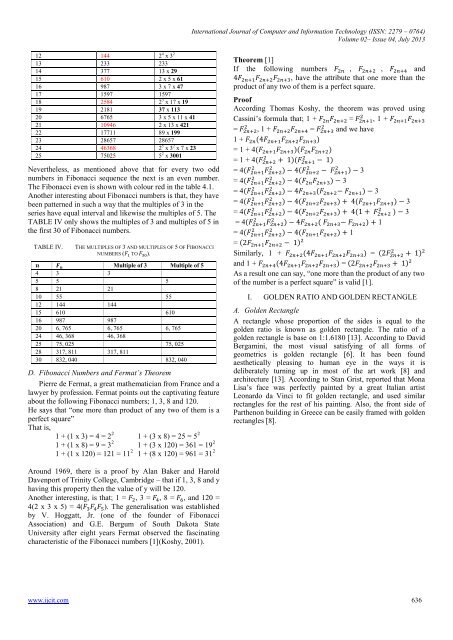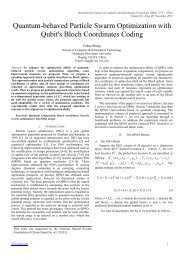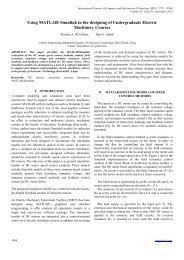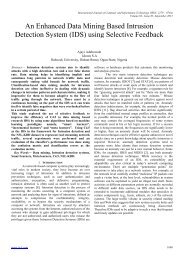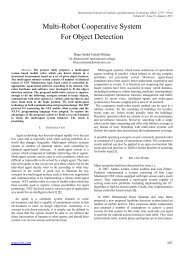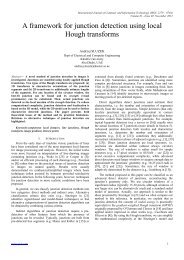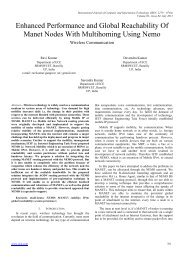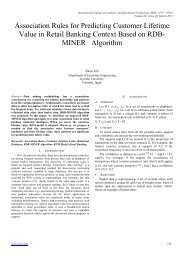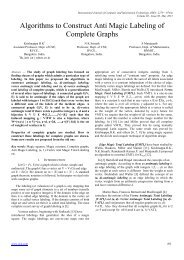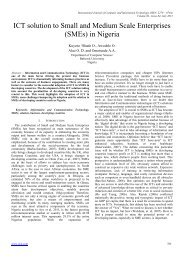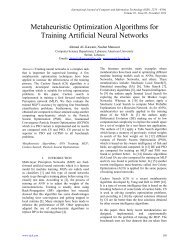Fibonacci Numbers and Golden Ratio in Mathematics and Science
Fibonacci Numbers and Golden Ratio in Mathematics and Science
Fibonacci Numbers and Golden Ratio in Mathematics and Science
Create successful ePaper yourself
Turn your PDF publications into a flip-book with our unique Google optimized e-Paper software.
International Journal of Computer <strong>and</strong> Information Technology (ISSN: 2279 – 0764)<br />
Volume 02– Issue 04, July 2013<br />
12 144 2 4 x 3 2<br />
13 233 233<br />
14 377 13 x 29<br />
15 610 2 x 5 x 61<br />
16 987 3 x 7 x 47<br />
17 1597 1597<br />
18 2584 2 3 x 17 x 19<br />
19 2181 37 x 113<br />
20 6765 3 x 5 x 11 x 41<br />
21 10946 2 x 13 x 421<br />
22 17711 89 x 199<br />
23 28657 28657<br />
24 46368 2 5 x 3 2 x 7 x 23<br />
25 75025 5 2 x 3001<br />
Nevertheless, as mentioned above that for every two odd<br />
numbers <strong>in</strong> <strong>Fibonacci</strong> sequence the next is an even number.<br />
The <strong>Fibonacci</strong> even is shown with colour red <strong>in</strong> the table 4.1.<br />
Another <strong>in</strong>terest<strong>in</strong>g about <strong>Fibonacci</strong> numbers is that, they have<br />
been patterned <strong>in</strong> such a way that the multiples of 3 <strong>in</strong> the<br />
series have equal <strong>in</strong>terval <strong>and</strong> likewise the multiples of 5. The<br />
TABLE IV only shows the multiples of 3 <strong>and</strong> multiples of 5 <strong>in</strong><br />
the first 30 of <strong>Fibonacci</strong> numbers.<br />
TABLE IV.<br />
THE MULTIPLES OF 3 AND MULTIPLES OF 5 OF FIBONACCI<br />
NUMBERS ( TO ).<br />
Multiple of 3 Multiple of 5<br />
4 3 3<br />
5 5 5<br />
8 21 21<br />
10 55 55<br />
12 144 144<br />
15 610 610<br />
16 987 987<br />
20 6, 765 6, 765 6, 765<br />
24 46, 368 46, 368<br />
25 75, 025 75, 025<br />
28 317, 811 317, 811<br />
30 832, 040 832, 040<br />
D. <strong>Fibonacci</strong> <strong>Numbers</strong> <strong>and</strong> Fermat’s Theorem<br />
Pierre de Fermat, a great mathematician from France <strong>and</strong> a<br />
lawyer by profession. Fermat po<strong>in</strong>ts out the captivat<strong>in</strong>g feature<br />
about the follow<strong>in</strong>g <strong>Fibonacci</strong> numbers; 1, 3, 8 <strong>and</strong> 120.<br />
He says that “one more than product of any two of them is a<br />
perfect square”<br />
That is,<br />
1 + (1 x 3) = 4 = 2 2 1 + (3 x 8) = 25 = 5 2<br />
1 + (1 x 8) = 9 = 3 2 1 + (3 x 120) = 361 = 19 2<br />
1 + (1 x 120) = 121 = 11 2 1 + (8 x 120) = 961 = 31 2<br />
Theorem [1]<br />
If the follow<strong>in</strong>g numbers , , <strong>and</strong><br />
, have the attribute that one more than the<br />
product of any two of them is a perfect square.<br />
Proof<br />
Accord<strong>in</strong>g Thomas Koshy, the theorem was proved us<strong>in</strong>g<br />
Cass<strong>in</strong>i’s formula that; 1 + = , 1 +<br />
= , 1 + = <strong>and</strong> we have<br />
1 +<br />
= 1 + 4<br />
= 1 + 4<br />
= 4 3<br />
= 4 3<br />
= 4 3<br />
= 4 3<br />
= 4 3<br />
= 4 1<br />
= 4 1<br />
=<br />
Similarly, 1 + =<br />
<strong>and</strong> 1 + =<br />
As a result one can say, “one more than the product of any two<br />
of the number is a perfect square” is valid [1].<br />
I. GOLDEN RATIO AND GOLDEN RECTANGLE<br />
A. <strong>Golden</strong> Rectangle<br />
A rectangle whose proportion of the sides is equal to the<br />
golden ratio is known as golden rectangle. The ratio of a<br />
golden rectangle is base on 1:1.6180 [13]. Accord<strong>in</strong>g to David<br />
Bergam<strong>in</strong>i, the most visual satisfy<strong>in</strong>g of all forms of<br />
geometrics is golden rectangle [6]. It has been found<br />
aesthetically pleas<strong>in</strong>g to human eye <strong>in</strong> the ways it is<br />
deliberately turn<strong>in</strong>g up <strong>in</strong> most of the art work [8] <strong>and</strong><br />
architecture [13]. Accord<strong>in</strong>g to Stan Grist, reported that Mona<br />
Lisa’s face was perfectly pa<strong>in</strong>ted by a great Italian artist<br />
Leonardo da V<strong>in</strong>ci to fit golden rectangle, <strong>and</strong> used similar<br />
rectangles for the rest of his pa<strong>in</strong>t<strong>in</strong>g. Also, the front side of<br />
Parthenon build<strong>in</strong>g <strong>in</strong> Greece can be easily framed with golden<br />
rectangles [8].<br />
Around 1969, there is a proof by Alan Baker <strong>and</strong> Harold<br />
Davenport of Tr<strong>in</strong>ity College, Cambridge – that if 1, 3, 8 <strong>and</strong> y<br />
hav<strong>in</strong>g this property then the value of y will be 120.<br />
Another <strong>in</strong>terest<strong>in</strong>g, is that; 1 = , 3 = , 8 = , <strong>and</strong> 120 =<br />
4(2 x 3 x 5) = 4( ). The generalisation was established<br />
by V. Hoggatt, Jr. (one of the founder of <strong>Fibonacci</strong><br />
Association) <strong>and</strong> G.E. Bergum of South Dakota State<br />
University after eight years Fermat observed the fasc<strong>in</strong>at<strong>in</strong>g<br />
characteristic of the <strong>Fibonacci</strong> numbers [1](Koshy, 2001).<br />
www.ijcit.com 636


